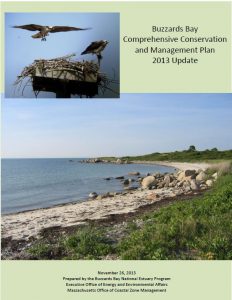2013 CCMP, Action Plan 19:
Planning for a Shifting Shoreline and Coastal Storms
About the new Buzzards Bay CCMP Action Plans
The Buzzards Bay Comprehensive Conservation and Management Plan (CCMP) was updated in November 2013 to reflect the great progress achieved since the original CCMP was finalized. You can download the entire document (buzzards-bay-ccmp-2013-update.pdf) or just this action plan Planning for a Shifting Shoreline and Coastal Storms.
Action Plan 18: Planning for a Shifting Shoreline and Coastal Storms
Problem
For millennia, the Buzzards Bay coastline has been subject to the rise in sea level and storms that have continued to erode and shift materials that change the shape, elevation, and position of the shoreline. These processes shift the locations of barrier beaches and alter wetland areas, resulting in the loss of habitat for certain species, and cause the migration of other habitats like salt marshes. Structures built in these hazard-prone areas can not only impede natural processes, but when they are de-stroyed in storms, they become hazards to public health and the environment. They can also become a financial burden to government. The frequency and intensity of these processes will likely increase in the coming decades due to climate change. Some state and federal pro-grams are creating moral hazards by promoting development in high-risk areas.
The Massachusetts Coastal Zone Management updat-ed its program plan with goals to prevent, eliminate, or significantly reduce threats leading to loss of life, destruction of property, and degradation of environmental resources that result from improper development. They also sought to limit public expenditures in coastal high hazard areas, allow natural physical coastal processes to continue unabated, to the extent feasible, and prioritize public expenditures for acquisition and relocation of structures out of hazardous coastal areas. Unfortunately, current state, federal, and local laws, regulations, and policies are far from achieving these goals.
Goals
Goal 18.1. Protect public health and safety from problems associated with coastal hazards including rising sea level, shifting shorelines, and damage from storms and storm surge.
Goal 18.2. Reduce the public financial burden caused by the destruction of or damage to coastal property.
Goal 18.3. Plan for shifting shorelines and the inland migration of buffering wetlands and shifting sand formations, and the species that utilize these habitats.
Objectives
Objective 18.1. To incorporate sea level rise, increased frequency and intensity of coastal flooding, and shoreline change phenomena into all relevant planning and management programs.
Objective 18.2. To develop a comprehensive strategy for handling existing structures in areas that will be affected by future shoreline changes and other coastal hazards.
Objective 18.3. To adopt regulatory and non-regulatory measures for guiding growth and development in areas that will be influenced by coastal flooding and new shorelines.
Objective 18.4. To encourage continued restructuring of the national flood insurance program to discourage development in flood prone areas.
Objective 18.5. To adopt emergency response plans to reflect additional needs and constraints caused by reduced access and increased flooding potential of developed coastlines.
Approaches
This action plan requires changes in regulations, pol-icies, and actions by all levels of government. Public spending for infrastructure in high risk areas should be avoided, and government should not create incentives for private construction in high-risk zones. The latter problem will require changes in the flood insurance program, and the kinds of actions required by the federal government in the aftermath of disaster relief aid. Municipalities will need to conduct evaluations of new risks caused by rising sea levels. They should adopt hazard mitigation plans, and participate in the FEMA community rating systems. RPAs and CZM should assist in these efforts. They also need to lead by example by not building new public structures in high-risk areas.
Costs and Financing
Much of the expenses associated with this action plan relate to conducting risk assessments, planning, and adopting or amending laws and regulations. These efforts might cost hundreds of thousands of dollars per community and require dedication of staff time. Those measures requiring regulatory or policy changes have nominal costs.
Measuring Success
Because of the rarity of catastrophic storms, and slowness of sea level rise, tracking programmatic actions, like completion of hazard mitigation plans, adoption of changes in the state building code, or adoption of local bylaws, ordinances, and regulations that support climate adaptation, will be the primary measures for tracking success.
